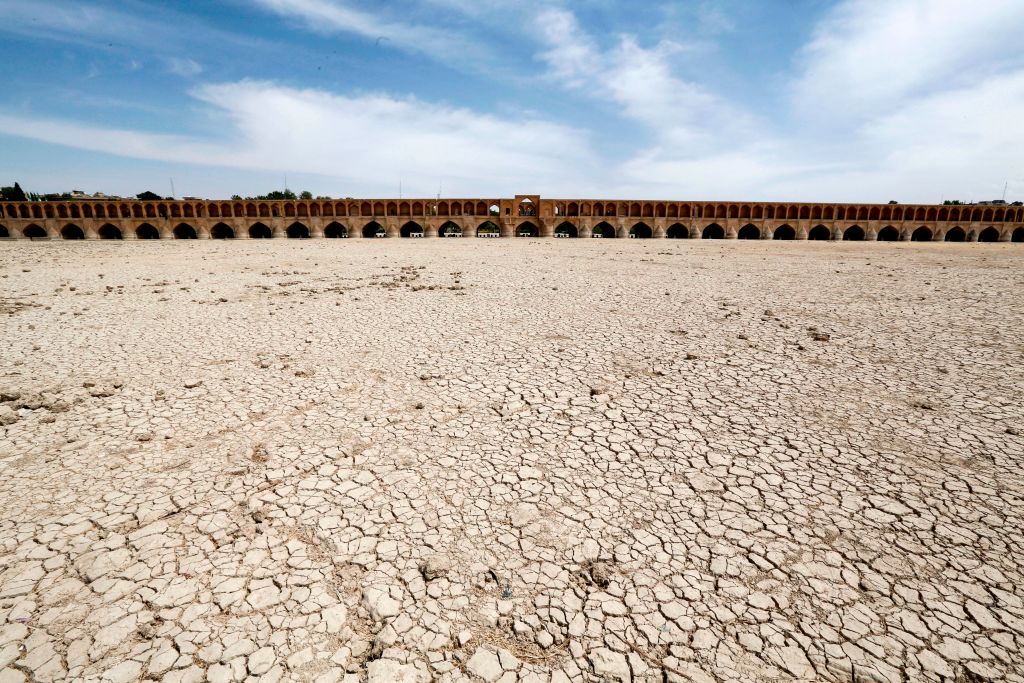
Iran’s government has spent this week trying to quell the protests that have rocked the country for the last three months. Officials put out several statements about unconfirmed plans to “review” the country’s hijab requirement for women and “disband” the morality police—two key factors in the Sept. 16 death of 22-year-old Mahsa Amini, which initially sparked the unrest.
So far, it hasn’t worked. On Monday, protesters launched a three-day general strike, designed to show that their uprising was never only about the restrictions placed on women. Iranians are also angry about poverty, economic dysfunction, corruption, a lack of freedom—a litany of government failings that mean many of the young people leading the rallies say they have “no future” as long as the Islamic regime remains in power.
Those failings also include the environment. The regime has disastrously mismanaged Iran’s water resources in the decades since the 1979 revolution. In a push for food self-sufficiency to shield the country from Western sanctions, authorities have championed a shift to unsustainable agricultural practices: they oversaw an expansion of water-intensive crops like sugar beet and a frenzy of poorly planned dam-building, and later well-digging, to collect water for irrigation. They also diverted rivers to provide water for heavy industries like steel manufacturing. These measures have overwhelmed the natural water cycle, drying up aquifers, rivers, and wetlands. The mismanagement, combined with climate change, caused the worst drought in half a century in 2021.
Read More: The Women of Iran are TIME’s 2022 Heroes of the Year
The water crisis is not the focus of the current demonstrations, which have mostly been led by city dwellers whose livelihoods are unlikely to be directly affected. But it is part of the accumulated anger now being unleashed. On the streets and on social media, protesters have referenced the dried up Urmia salt lake and Zayandeh Rud river, which have emerged as symbols of the regime’s incompetence. Other environmental problems, like air pollution, are cited as motivations for rebellion in viral protest anthem Baraye (“Because of”).
More from TIME
Environmental challenges can be a “uniting” factor for Iranians, says Kaveh Madani, a scientist who served as deputy head of the Iranian government’s environment department under former President Hassan Rouhani, before fleeing to the U.S. in 2018 amid a crackdown on environmentalists. “Everyone is unhappy when a big wetland dries up. It brings everyone together,” Madani says. “This is why the environmental activists have been targeted by Iran’s security agencies so much.”
A version of this story first appeared in the Climate is Everything newsletter. To sign up, click here.
Water’s growing threat to Iran’s regime
Even if the regime manages to stymie the current urban-led unrest, it won’t be long before the next June-August dry season carries the risk of new water shortages in rural areas, which for the last two years have triggered protests among farmers—potentially mobilizing a demographic that has not been as drawn to the women’s rights cause. In late November, hacking group Black Reward published what they claim is a leaked document from a news agency linked to Iran’s Islamic Revolutionary Guard Corps, in which officials express concern that water shortages could spark demonstrations in several provinces.

Discontent over water is only likely to grow. Climate change is making Iran hotter and drier, exacerbating the human-made problems. A 2019 study on Iran’s climate outlook for 2025-2049, published in Nature, found “a grim picture” of increasingly severe droughts and floods, with the driest regions potentially becoming uninhabitable.
Climate campaigners say the government’s efforts to avert that situation, including a restoration program for Urmia, have largely relied on unsustainable solutions like diverting water from under-used basins. Truly ensuring water security for Iran would require radical reforms to diversify the economy from agriculture and other water-intensive industries—something today’s political system makes all but impossible, according to Madani. “No president within the current structure can address the environmental problems.”
All of that will make it harder and harder for the government to prevent unrest from boiling over in Iran in the future, Madani adds. “Water is affecting the resilience of the system. They’re close to their tipping point.”
More Must-Reads from TIME
- How Donald Trump Won
- The Best Inventions of 2024
- Why Sleep Is the Key to Living Longer
- Robert Zemeckis Just Wants to Move You
- How to Break 8 Toxic Communication Habits
- Nicola Coughlan Bet on Herself—And Won
- Why Vinegar Is So Good for You
- Meet TIME's Newest Class of Next Generation Leaders
Write to Ciara Nugent at ciara.nugent@time.com